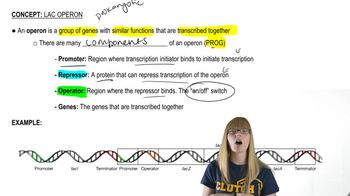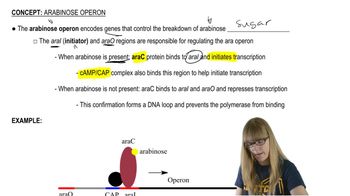Here are the essential concepts you must grasp in order to answer the question correctly.
Lac Operon
The lac operon is a well-studied model of gene regulation in bacteria, particularly E. coli. It consists of genes responsible for the metabolism of lactose, controlled by a promoter and an operator region. The operon is regulated by the presence or absence of lactose, which influences the binding of the lac repressor protein, thereby controlling gene expression.
Recommended video:
Lac Repressor Protein
The lac repressor is a protein that binds to the operator region of the lac operon, preventing transcription of the downstream genes when lactose is absent. Its ability to inhibit gene expression demonstrates its role as a repressor. The repressor's structure allows it to specifically recognize and bind to the operator, blocking RNA polymerase from initiating transcription.
Recommended video:
Evidence of Repression
Evidence that the lac repressor functions as a repressor includes experiments showing that in the presence of lactose, the repressor is inactivated, allowing transcription to occur. Additionally, genetic studies have identified mutations in the lac repressor that either prevent binding to the operator or alter its function, further supporting its role in regulating the operon. These findings illustrate the dynamic interaction between the repressor and the operon in response to environmental changes.
Recommended video:
 Verified step by step guidance
Verified step by step guidance


